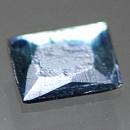|
|
||||||||||||||||
|
||||||||||||||||
|
||||||
|
|
|
|
Vivianite
|
|
| | |
| Discovered in 1817; IMA status: Valid (pre-IMA; Grandfathered) | ||
|
| ||
|
Chemistry |
|
|
| |
|
Fe2+3(PO4)2 • 8H2O | |
|
|
Hydrated Iron Phosphate |
|
Molecular Weight: |
501.61 gm |
|
Composition: |
Iron |
33.40 % |
Fe |
42.97 % |
FeO |
|
|
Phosphorus |
12.35 % |
P |
28.30 % |
P2O5 |
|
|
Hydrogen |
3.22 % |
H |
28.73 % |
H2O |
|
|
Oxygen |
51.03 % |
O |
|
|
|
|
|
100.00 % |
|
100.00 % |
= TOTAL OXIDE |
|
|
|
||||
|
Classification |
|
|
| |
|
Phosphates | |
|
7/C.13-40 | |
|
|
8 : PHOSPHATES, ARSENATES, VANADATES
|
|
Related to: |
Vivianite Group |
|
Members of Group: |
Vivianite Group: Annabergite, Arupite, Baricite, Erythrite, Hörnesite, Köttigite, Manganohörnesite, Parasymplesite, Vivianite |
|
Varieties: |
None |
|
Synonyms: |
Angelardite, Anglarite (of Berthier), Anglarite (of Kobell), Blue Iron Earth, Blue Ocher, Glaucosiderite, Mullicite, Native Prussian Blue, Paravivianite, Phosphate of Iron |
|
|
|
|
Crystal Data |
|
|
|
|
|
Prismatic crystals, to 1.3 m; flattened on [100] or [010], somewhat elongated along [100], many modifying forms, dominated by {100}, [010}, may be rounded or corroded; stellate groups, incrustations, concretionary, earthy, powdery. |
|
|
Translation gliding T(010), t[001] |
|
|
|
|
|
Physical Properties |
|
|
|
|
|
Perfect on {010} |
|
|
Fibrous |
|
|
Flexible, Sectile |
|
|
1.5 - 2.0 |
|
|
2.60 - 2.70 (g/cm3) |
|
|
Not Fluorescent |
|
|
Not Radioactive |
|
|
Other: |
Readily soluble in acids. Melting point = 1114°. Darkens in colour in H2O2. |
|
|
|
|
Optical Properties |
|
|
|
|
|
Colorless, very pale green, with oxidation becoming dark blue, dark greenish blue, Indigo-blue, then black; colorless to blue in transmitted light |
|
|
Translucent, Transparent |
|
|
Vitreous. Pearly on cleavages. Dull when earthy |
|
|
1.579 - 1.675 Biaxial ( + ) |
|
|
0.0470 - 0.0730 |
|
|
Weak; r < v |
|
|
Visible.
|
|
|
Other: |
The refractive indices increase with increasing oxidation, the birefringence decreases, and the pleochroism on {010} becomes stronger. |
|
|
|
|
Occurances |
|
|
|
|
|
Geological Setting: |
A secondary mineral in the oxidized zone of metallic ore deposits and complex granite pegmatites; replacing organic material in fossil bones, lake sediments, and in bog-iron ores and peat bogs; rarely in caves. |
|
Common Associations: |
Limonite, Ludlamite, Metavivianite, Pyrite, Pyrrhotite, Santaclarite |
|
Common Impurities: |
Mn, Mg, Ca |
|
Type Locality: |
Wheal Kind (Wheal Kine), West Wheal Kitty group, St Agnes, St Agnes District, Cornwall, England, UK |
|
Year Discovered: |
1817 |
|
View mineral photos: | |
|
|
|
|
More Information |
|
|
|
|
|
| |
|
|
|
|
Vivianite
is found in numerous localities, even for well-crystallized
material. In England, from [Wheal Kind,] St. Agnes,
and other mines in St. Just and Kea, Cornwall. At Hagendorf,
Bavaria, Germany. From the Stari Trg mine, Trepca, Serbia.
On the Taman Peninsula, Russia. Around Kerch, Crimean
Peninsula, Ukraine. Huge crystals from Anloua, near
Ngaoundéré, Cameroon. In the USA, from the Blackbird
Mine, Lemhi County, Idaho; in the Treece and Ibex mines,
Leadville, Lake County, Colorado; at the Bingham Canyon
mine, Salt Lake County, Utah; from Richmond, Henrico
County, Virginia; at the Foote mine, Kings Mountain,
Cleveland County, North Carolina. In Mexico, from Santa
Eulalia, Chihuahua. In Brazil, from the Énio pegmatite
mine, northeast of Galiléia, Minas Gerais. Exceptional
examples from Bolivia, at Poopo, Llallagua, Avicaya,
Tazna, Monserrat, Morococala, Tatasi, and elsewhere.
In the Ashio mine, Tochigi Prefecture, Japan. |
|
|
We
have not photographed our Vivianite gems
yet. Please
check back soon. |
